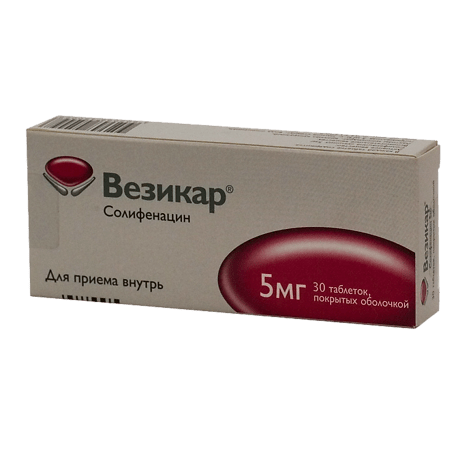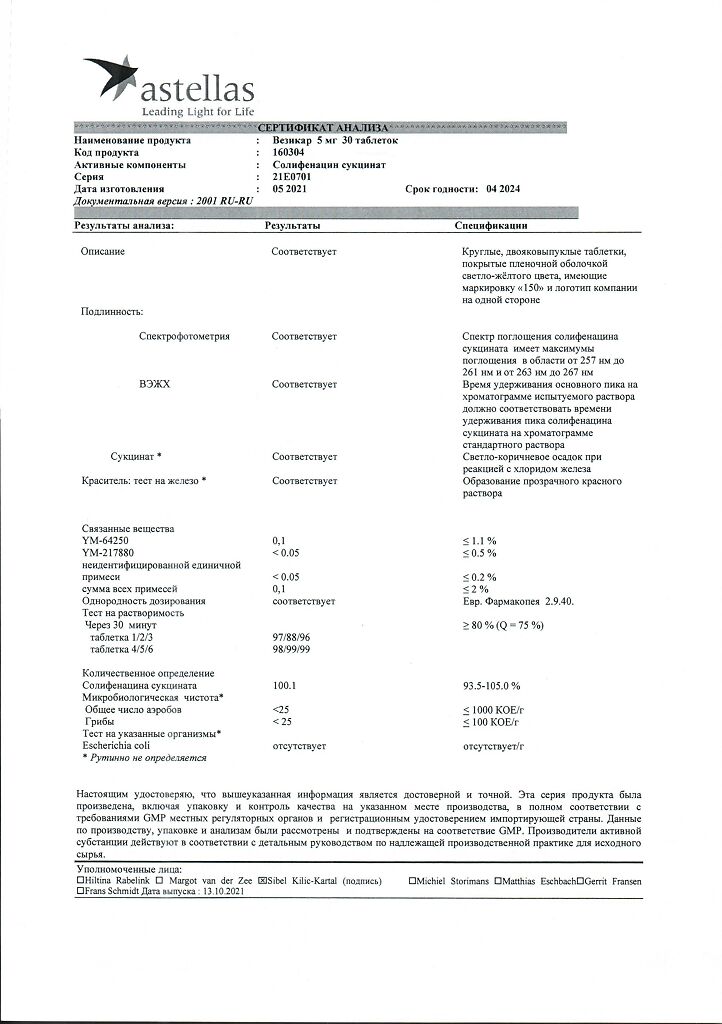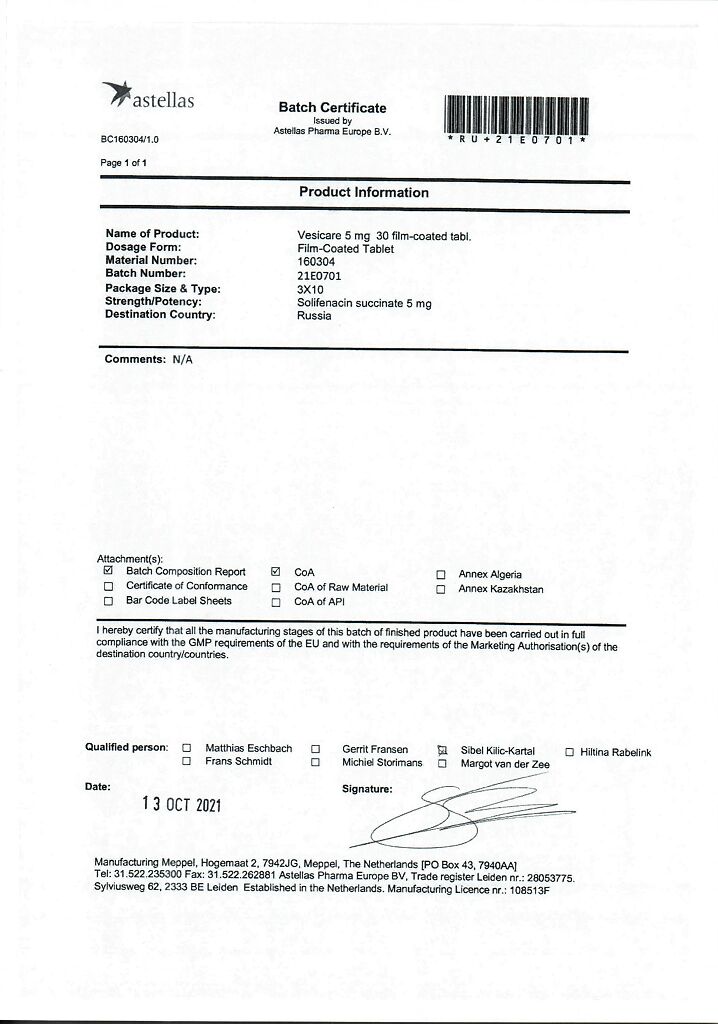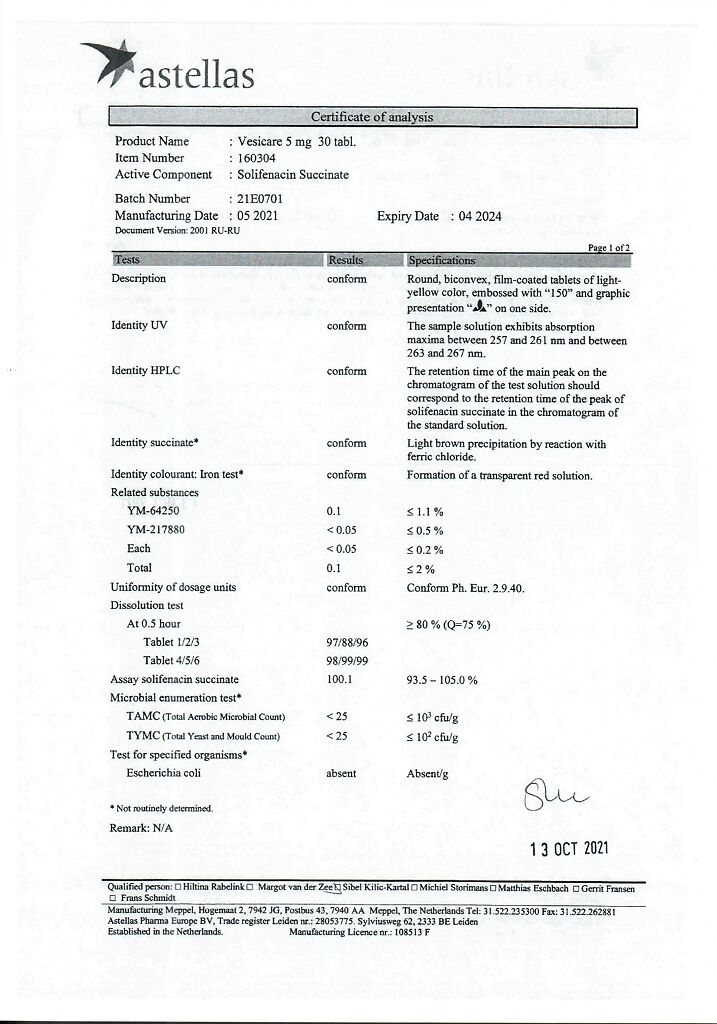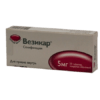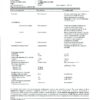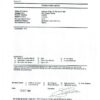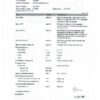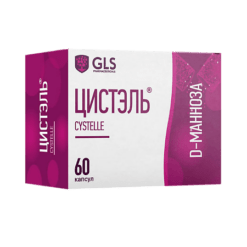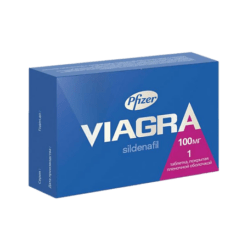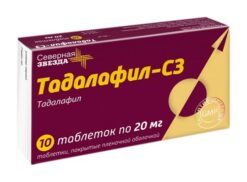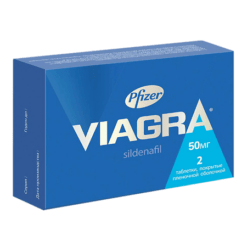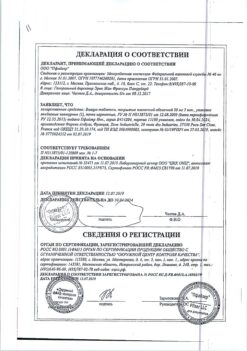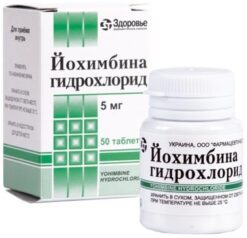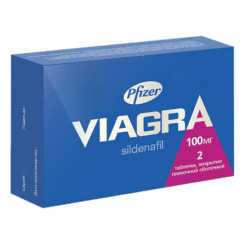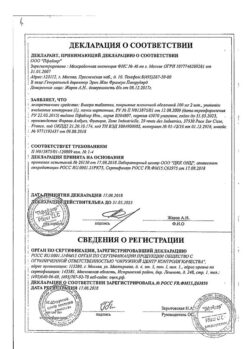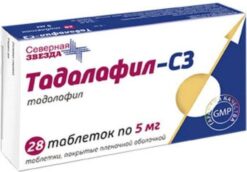No products in the cart.
Vesicar, 5 mg 30 pcs.
€24.68 €20.56
Description
Pharmacodynamics
In vitro and in vivo pharmacological studies have shown that solifenacin is a specific competitive inhibitor of muscarinic receptors, predominantly of the M3 subtype. Solifenacin was also found to have low affinity or no interaction with other receptors and ion channels.
The efficacy of Vesicar, studied in several double-blind, randomized controlled clinical trials in men and women with overactive bladder syndrome, was observed during the first week of treatment and stabilized during the following 12 weeks of treatment. The maximal effect of Vesicar can be detected after 4 weeks. The efficacy lasts for long-term use (at least 12 months).
Pharmacokinetics
General characteristics
Absorption. Cmax is reached after 3-8 h. The time to reach Cmax is independent of the dose. Cmax and AUC increase in proportion to dose increase from 5 to 40 mg. Absolute bioavailability is 90%. Food intake has no effect on Cmax and AUC of solifenacin.
Distribution. The volume of distribution of solifenacin after intravenous administration is 600 l. Solifenacin is largely (about 98%) bound to plasma proteins, mainly to α1-acid glycoprotein.
Metabolism. Solifenacin is actively metabolized by the liver, mainly by cytochrome P450 3A4 (CYP3A4). However, there are alternative metabolic pathways by which solifenacin may be metabolized. The systemic Cl of solifenacin is about 9.5 l/h, and the final T1/2 is 45-68 h. After oral administration the following metabolites were identified in plasma in addition to solifenacin: one pharmacologically active (4R-hydroxysolifenacin) and three inactive (N-glucuronide, N-oxide and 4R-hydroxy-N-oxide solifenacin).
Elimination. After a single administration of 10 mg of 14C-labeled solifenacin after 26 days, about 70% of the radioactivity was detected in the urine and 23% in the feces. In the urine, approximately 11% of radioactivity was found as unchanged active ingredient, about 18% as N-oxide metabolite, 9% as 4R-hydroxy-N-oxide metabolite, and 8% as 4R-hydroxy metabolite (active metabolite).
The pharmacokinetics of solifenacin are linear over the therapeutic dose range.
Peculiarities of pharmacokinetics in certain categories of patients
Age. There is no need to adjust the dose according to the age of patients. Studies have shown that the exposure of solifenacin (5 and 10 mg), expressed as AUC, was similar in healthy elderly individuals (65 to 80 years) and healthy young individuals (max, was slightly lower, and the final T1/2 was approximately 20% longer in the elderly. These minor differences are not clinically significant.
The pharmacokinetics of solifenacin have not been determined in children and adolescents.
Pol. The pharmacokinetics of solifenacin are independent of the gender of the patient.
Race. Race has no effect on the pharmacokinetics of solifenacin.
Renal insufficiency. AUC and Cmax of solifenacin in patients with mild to moderate renal impairment are not significantly different from those in healthy volunteers. In patients with severe renal insufficiency (creatinine Cl ≤30 ml/min) solifenacin exposure is significantly higher (increase in Cmax is about 30%, AUC – >100% and T1/2 – more than 60%). There is a statistically significant relationship between creatinine clearance and solifenacin clearance. Pharmacokinetics in patients undergoing hemodialysis have not been studied.
Hepatic failure. In patients with moderate hepatic insufficiency (Child-Pugh index from 7 to 9) Cmax value is not changed, AUC is increased by 60%, T1/2 is doubled. Pharmacokinetics in patients with severe hepatic impairment was not determined.
Indications
Indications
Urgent (imperative) urinary incontinence, frequent urination and urgent (imperative) urge to urinate, characteristic of patients with overactive bladder syndrome.
Pharmacological effect
Pharmacological effect
Pharmacodynamics
Pharmacological studies conducted in vitro and in vivo have shown that solifenacin is a specific competitive inhibitor of muscarinic receptors, predominantly of the M3 subtype. Solifenacin has also been found to have low affinity or does not interact with other receptors and ion channels.
The effectiveness of Vesicare, studied in several double-blind randomized controlled clinical trials in men and women with overactive bladder syndrome, was observed within the first week of treatment and stabilized over the subsequent 12 weeks of treatment. The maximum effect of Vesicare can be detected after 4 weeks. Efficiency is maintained over long-term use (at least 12 months).
Pharmacokinetics
General characteristics
Absorption. Cmax is reached within 3–8 hours. The time to reach Cmax does not depend on the dose. Cmax and AUC increase in proportion to increasing doses from 5 to 40 mg. Absolute bioavailability – 90%. Food intake does not affect the Cmax and AUC of solifenacin.
Distribution. The volume of distribution of solifenacin after intravenous administration is 600 l. Solifenacin is largely (about 98%) bound to plasma proteins, predominantly to α1-acid glycoprotein.
Metabolism. Solifenacin is extensively metabolized by the liver, predominantly by cytochrome P450 3A4 (CYP3A4). However, there are alternative metabolic pathways through which solifenacin can be metabolized. The systemic Cl of solifenacin is about 9.5 l/h, and the final T1/2 is 45–68 hours. After oral administration of the drug in plasma, in addition to solifenacin, the following metabolites were identified: one pharmacologically active (4R-hydroxysolifenacin) and three inactive (N-glucuronide, N-oxide and 4R-hydroxy-N-oxide of solifenacin).
Excretion. After a single dose of 10 mg 14C-labeled solifenacin administered after 26 days, approximately 70% of the radioactivity was detected in urine and 23% in feces. In urine, approximately 11% of the radioactivity was found as unchanged active substance, about 18% as the N-oxide metabolite, 9% as the 4R-hydroxy-N-oxide metabolite, and 8% as the 4R-hydroxy metabolite (the active metabolite).
The pharmacokinetics of solifenacin is linear over the therapeutic dose range.
Features of pharmacokinetics in certain categories of patients
Age. There is no need to adjust the dose depending on the age of the patients. Studies have shown that exposure to solifenacin (5 and 10 mg), expressed as AUC, was similar in healthy elderly individuals (65 to 80 years of age) and healthy young individuals (max was slightly lower and terminal T1/2 was approximately 20% longer in elderly individuals. These minor differences are not clinically significant.
The pharmacokinetics of solifenacin have not been determined in children and adolescents.
Floor. The pharmacokinetics of solifenacin does not depend on the gender of the patient.
Race. Race does not affect the pharmacokinetics of solifenacin.
Kidney failure. The AUC and Cmax of solifenacin in patients with mild to moderate renal impairment do not differ significantly from the corresponding values in healthy volunteers. In patients with severe renal failure (creatinine clearance ≤30 ml/min), exposure to solifenacin is significantly higher (increase in Cmax is about 30%, AUC is >100% and T1/2 is more than 60%). There was a statistically significant relationship between creatinine clearance and solifenacin clearance. Pharmacokinetics in patients undergoing hemodialysis have not been studied.
Liver failure. In patients with moderate liver failure (Child-Pugh score from 7 to 9), the Cmax value does not change, AUC increases by 60%, T1/2 doubles. Pharmacokinetics in patients with severe hepatic impairment have not been determined.
Special instructions
Special instructions
Before you start treatment with Vesicare, you should determine whether there are other causes of frequent urination (heart failure or kidney disease). If a urinary tract infection is detected, appropriate antibacterial treatment should be started. Vesicare should be used with caution in patients:
– with clinically significant obstruction of the bladder outlet, leading to the risk of developing urinary retention;
– with gastrointestinal obstructive diseases;
– at risk of decreased gastrointestinal motility;
– with severe renal (Cl creatinine ≤30 ml/min) and moderate hepatic (Child-Pugh score from 7 to 9) failure; Doses for these patients should not exceed 5 mg;
– while taking a strong CYP3A4 inhibitor, such as ketoconazole;
– with hiatal hernia, gastroesophageal reflux and patients simultaneously taking medications (for example, bisphosphonates) that can cause or worsen esophagitis;
– with autonomic neuropathy.
Patients with rare hereditary disorders of galactose tolerance, lactase deficiency of the Lapps (Sami), glucose-galactose malabsorption should not take the drug.
Solifenacin, like other anticholinergic drugs, may cause blurred vision and (rarely) drowsiness and fatigue, which may impair the ability to drive and operate machines.
Active ingredient
Active ingredient
Solifenacin
Composition
Composition
1 film-coated tablet contains
active ingredient:
solifenacin succinate 5 mg;
excipients:
lactose monohydrate;
corn starch;
hypromellose 3 mPa s;
magnesium stearate;
purified water
Pregnancy
Pregnancy
There are no clinical data on women who became pregnant while taking solifenacin.
Animal studies have shown no direct adverse effects on fertility, embryonic/fetal development or childbirth.
Caution should be exercised when prescribing this drug to pregnant women.
There is no data on the excretion of solifenacin in milk in humans.
The use of Vesicare is not recommended during breastfeeding.
Contraindications
Contraindications
hypersensitivity to the components of the drug Vesicare;
urinary retention;
severe gastrointestinal diseases (including toxic megacolon);
myasthenia gravis;
angle-closure glaucoma;
hemodialysis;
severe liver failure;
severe renal failure or moderate liver failure during concomitant treatment with strong CYP3A4 inhibitors, such as ketoconazole.
Side Effects
Side Effects
Vesicare may cause side effects related to the anticholinergic effects of solifenacin, which are usually mild to moderate. The frequency of these unwanted effects depends on the dose. The most commonly reported side effect of Vesicare is dry mouth. It was observed in 11% of patients receiving a dose of 5 mg per day, in 22% of patients receiving a dose of 10 mg per day, and in 4% receiving placebo. The severity of dry mouth was usually mild and only in rare cases led to treatment interruption. Overall, treatment adherence (compliance) was very high.
The table below summarizes the remaining side effects reported in clinical trials of Vesicare:
Side effectsCommon
(≥1/100, Uncommon
(≥1/1000, Rare
(≥1/10000, Gastrointestinal disorders constipation, nausea, dyspepsia, abdominal pain, gastroesophageal reflux disease, dry pharynx, colonic obstruction, coprostasis Infections and infestations, urinary tract infection Disorders of the nervous system drowsiness, dysgeusia (impaired taste) Visual disorders blurred vision (impaired accommodation) dry eyes Disorders of the general condition fatigue, swelling of the lower extremities Disorders of the respiratory system, chest and mediastinum dry nasal cavity Disorders of the skin and subcutaneous tissue dry skin Disorders of the kidneys and urinary tract difficulty urinating urinary retention
Allergic reactions were not observed during clinical trials. However, the possibility of allergic reactions should not be excluded.
Interaction
Interaction
Pharmacological interaction
Concomitant treatment of drugs with anticholinergic properties can lead to more pronounced therapeutic and undesirable effects. After stopping solifenacin, take approximately a week off before starting treatment with another anticholinergic drug. The therapeutic effect may be reduced by concomitant use of cholinergic receptor agonists. Solifenacin may reduce the effect of drugs that stimulate gastrointestinal motility, such as metoclopramide and cisapride.
Pharmacokinetic interaction
In vitro studies have shown that, at therapeutic concentrations, solifenacin does not inhibit CYP1A1/2, CYP2C9, CYP2C19, CYP2D6 or CYP3A4 isolated from human liver microsomes. Therefore, solifenacin is unlikely to alter the clearance of drugs metabolized by these CYP enzymes.
Impact of other drugs on the pharmacokinetics of solifenacin
Solifenacin is metabolized by CYP3A4. Co-administration of ketoconazole (200 mg per day), a strong CYP3A4 inhibitor, caused a twofold increase in the AUC of solifenacin, and at a dose of 400 mg per day, a threefold increase. Therefore, the maximum dose of Vesicare should not exceed 5 mg if the patient is concomitantly taking ketoconazole or therapeutic doses of other strong CYP3A4 inhibitors (such as ritonavir, nelfinavir, itraconazole). Concomitant treatment with solifenacin and a strong CYP3A4 inhibitor is contraindicated in patients with severe renal impairment or moderate hepatic impairment. Since solifenacin is metabolized by CYP3A4, pharmacokinetic interactions with other CYP3A4 substrates with higher affinity (verapamil, diltiazem) and with CYP3A4 inducers (rifampicin, phenytoin, carbamazepine) are possible.
The effect of solifenacin on the pharmacokinetics of other drugs
Oral contraceptives: no pharmacokinetic interaction has been identified between solifenacin and combined oral contraceptives (ethinyl estradiol/levonorgestrel).
Warfarin: Vesicare did not cause changes in the pharmacokinetics of R-warfarin or S-warfarin or their effect on PT.
Digoxin: Vesicare had no effect on the pharmacokinetics of digoxin.
Overdose
Overdose
The highest dose of solifenacin used by volunteers was 100 mg as a single dose. The most commonly reported side effects at this dose were headache (mild), dry mouth (moderate), dizziness (moderate), drowsiness (mild), and blurred vision (moderate). No cases of acute overdose have been reported.
Treatment: administration of activated carbon, gastric lavage; vomiting should not be induced.
As with overdose of other anticholinergic drugs, symptoms should be treated as follows:
– for severe central anticholinergic effects (hallucinations, severe excitability) – physostigmine or carbachol;
– for convulsions or severe excitability – benzodiazepines;
– in case of respiratory failure – artificial respiration;
– for tachycardia – beta-blockers;
– in case of urinary retention – catheterization;
– for mydriasis – instill pilocarpine into the eyes and/or darken the room where the patient is.
As with overdose of other anticholinergic drugs, special attention should be paid to patients with an established risk of QT prolongation (i.e., hypokalemia, bradycardia, and concomitant use of drugs known to prolong the QT interval) and patients with cardiac disease (myocardial ischemia, arrhythmia, congestive heart failure).
Storage conditions
Storage conditions
At a temperature not exceeding 25 °C
Shelf life
Shelf life
3 years
Manufacturer
Manufacturer
Astellas Pharma Europe B.V., Netherlands
Additional information
| Shelf life | 3 years |
|---|---|
| Conditions of storage | At a temperature not exceeding 25 °C |
| Manufacturer | Astellas Pharma Europe B.V., Netherlands |
| Medication form | pills |
| Brand | Astellas Pharma Europe B.V. |
Related products
Buy Vesicar, 5 mg 30 pcs. with delivery to USA, UK, Europe and over 120 other countries.

